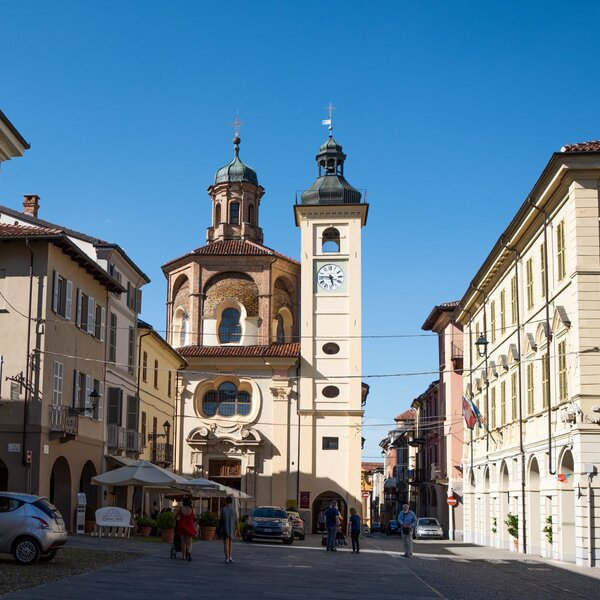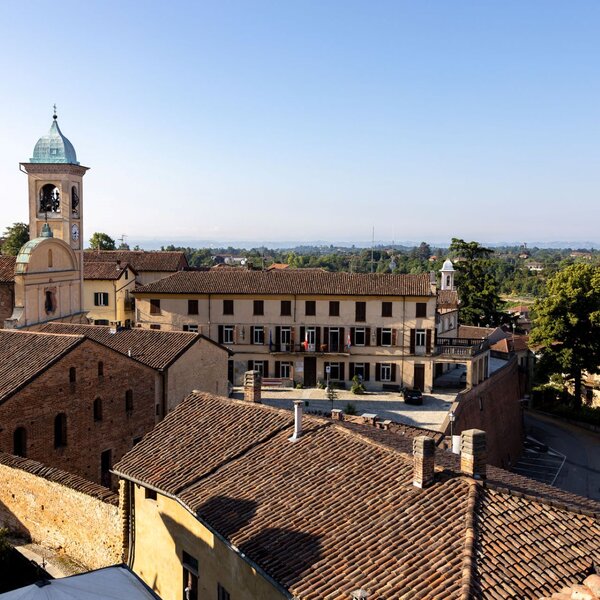Moncalvo watches over the province of Asti just as it was once the key and shield of Monferrato. Thanks to its position, or perhaps because of it, it has always been a protagonist in the historical events of this part of the region.Already the capital of Monferrato, the town boasts gourmet traditions of boiled meats and truffles, as well as the legendary love of King Victor Emmanuel II for the beautiful Rosa Vercellana, a native of Moncalvo, who was first the lover and then the morganatic wife of the King.
Stretched out on a hill like an impenetrable stronghold blocking the way to Casale and the plain, Moncalvo was, over the centuries, the property of the Marquises of Monferrato, the Gonzaga family and, finally, the Savoys. In 1705 Duke Ferdinando Carlo Gonzaga of Mantua named it City, a title also confirmed by the Savoy family, specifically by Victor Amadeus III in 1775.
Find out more

Canelli, the "Gateway to the World"
Find out moreThe centuries-old prestige of the village was such that Guglielmo Caccia chose "Moncalvo" (he was born in Montabone) as his professional name, and it was under this nickname that he went down in history as the greatest painter of the Piedmontese Counter-Reformation, whose canvases adorn many of the churches in the area. Another city glory is the fine cabinetmaker Gabriele Capello, the last talent of the extraordinary Piedmontese school, who worked in a modern and highly personal style for Carlo Alberto and the entire Royal House.
Alongside its noble historical heritage and artistic treasures, Moncalvo also has a strong gastronomic tradition, as shown by the colourful Festival delle Cucine Monferrine, the historic Fiera del Bue Grasso and, above all, the Fiera del Tartufo. As a matter of fact, the Truffle Fair of Moncalvo is, after Alba, the most important fair in Piedmont, boasting an ancient tradition and, above all, some of the best truffle grounds ever.
Our itinerary can only start from the large square in front of the Castle (Piazza Carlo Alberto), for centuries an open space used for the cattle market, barely refined by the 19th-century porticoes running alongside the surviving ramparts.
Find out more

Nizza, amidst Barbera and Bagna Cauda
Find out moreThen, the large square converges to join the peculiar nineteenth-century theatre which, if it were ever needed, reaffirms Moncalvo's ambition and coat of arms: this is the city' s parlour with its cafés and many historic shops, and where the two main streets start: the one along the ridge, Via Cissello, known as del Municipio (of the Town Hall), and Via Maestra (Via XX Settembre), which everyone here calls " la Fracia".
We first walk down the street towards the Town Hall, which is housed in a wing of the former Orsoline Convent, founded by Moncalvo's first daughter, Orsola, a remarkable painter too ( a rarity in those days); the building is worth a visit, especially for its monumental andron. However, the most pleasant and unexpected surprise is undoubtedly the other wing of the convent, which houses in the Museo Civico (Civic Museum) the Montanari Collection, donated by this famous ambassador to the city and which is truly astonishing in terms of the man's wealth and good taste. It is practically a summa of the best artists of the 20th century, to which are added the African and Japanese collections, always of the highest level, as well as the art treasure of the Town Hall, which boasts other beautiful surprises.
Next comes Via Asilo which, together with Via Caccia first and then Via Goito, runs at a lower level along the same south-facing ridge on which the oldest buildings and houses are arranged. Via Goito turns sharply south to end up on the ramparts of Via Roma, from which it immediately climbs back up Via Capello to join Via Testa-Fochi, which then surprisingly opens up beyond a large vault into a tiny square with two masterpieces by Magnocavallo, an important 18th-century Casale architect, poised between Baroque and Neoclassicism. To the left stands the Church of the Madonna delle Grazie, now the Sanctuary of Teresa of Calcutta, with its stern, windowless façade, which, however, features impressive interior lighting and refined stucco decorations. To the right is Palazzo Testafochi, whose grandeur recalls the splendour of the past.
Find out more

San Damiano d'Asti, a chessboard on the Borbore
Find out moreThe street reaches Piazza del Teatro again, on the corner of what remains of the Palace of the Marquises of Monferrato, a rich 15th-century building with two rows of round terracotta windows and elaborate stringcourses.
Now it is time to walk down the Fracia, the true commercial heart of the town and a paradise with ancient signs marking out both sides of the steep descent towards the ancient Porta sottana gate of the village. Here we find the mediaeval Casa Lanfrancone which, although remodelled, is a fine example of Piedmontese Gothic, the Casa Montanari with the four commemorative Stolpersteine, the stumbling stones placed there in memory of the Jewish citizens deported and killed by the Nazis; and we also find the parish Church of Sant'Antonio, whose "separate" bell tower in Via Capello is the tallest building in Moncalvo.
Further on, we are already almost in the countryside, between the ramparts that blocked the eastern access to the ridge and the cemetery. The Israelite cemetery is on the road to Grazzano Badoglio. The surroundings of Moncalvo are described in the itinerary Lower Monferrato of Moncalvo.
Find out more

Lower Monferrato of Moncalvo
Find out moreWalking back and up to the castle from Via Vittorio Veneto, you will find the Bottega del Vino (Wine Shop) in the Bonaventura Tower: a must-see is the rediscovered secret walkway that runs along all the walls up to the last tower, leading to the Tourist Office, and finally, you reach the most beautiful Sphaeristerium in Italy (but please take note that in Monferrato the local game is tamburello or tambass and not pallapugno or balon, which is typical of the Langhe), the Fossa dei Leoni, enclosed by the massive towers of the Monferrato fortress. Finally, by climbing one of the many staircases of the Belvedere, you return to your starting point.
Text by Pietro Giovannini
PLEASE NOTE: Responsibility for the maintenance and practicability of the various trails lies with the municipalities where the routes are located. The Tourist Board, therefore, cannot be held responsible for any inefficiencies, but is willingly available to collect your reports so that they can be forwarded to the authorities concerned.


